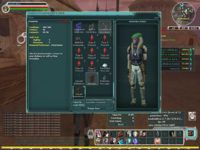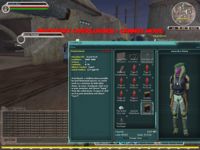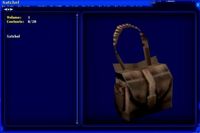Description
Template (Game Messages)
|
Related Tags
| 25%
|
This document has been partially completed.
|
|
| Mechanics
|
This document is about game mechanics.
|
|
|
Completion Guide -
- 0% - No substantive information available on game feature
- 25% - page has been started but not completed
- 50% - page is as complete as possible with the currently available information but probably needs more research done on the subject matter
- 75% - page is probably complete but needs to be reviewed for accuracy of the page content and to make sure that no information is missing about the game feature
- 100% - page has been reviewed and compared against enough sources to the extent that there is reasonable confidence that the game feature is completely documented.
|
|
Game Mechanics
Some objects are containers, and one of the choices on the radial menu will be "Open". (If it's an NPC's corpse, the option will be called "Loot" instead, but it means the same thing).
When you open a container, you will see a container window. This window shows you the contents of the container. You can pick things out from the container and drag them into another container or into your inventory or use the Pickup radial on the object inside the container to automatically obtain the item.
Container Types
There are a number of types of containers:
-
- Creatures and mobs are given inventories as well. One of these inventories includes equippable weapons that an npc may choose from in order to fight with. Players do not have access to this although at one point they could use the /open command to view and remove contents from npcs, however this was a bug
- A second sort of mob inventory includes the lootable objects that will be generated on an npc or creature upon being defeated. Players may only retrieve objects from these types of inventories and are not given permissions to modify them by placing items inside.
- These have a storage capacity of 5. Players may not open it or add items into them. The player uses a special option (fillet) to extract the contents.
- These have storage capacities limited by the Vendor Item Limit skill modifier on players. Each tangible object placed on a vendor counts as one unique object against that vendor item limit.
- Lightsabers
- These hold varying amounts of Force Crystals and/or Krayt Dragon Pearl items, depending on the generation level of the item. The lowest generations (training and generation 1) can hold only one item where as each progression generation up to 4 can hold an increasing amount of these items up to 5 maximum at the fourth generation.
- Training Lightsaber
- Double-Bladed First Generation Lightsaber
- Double-Bladed Fourth Generation Lightsaber
- Double-Bladed Second Generation Lightsaber
- Double-Bladed Third Generation Lightsaber
- One-handed First Generation Lightsaber
- One-handed Fourth Generation Lightsaber
- One-handed Second Generation Lightsaber
- One-handed Third Generation Lightsaber
- Two-handed First Generation Lightsaber
- Two-handed Fourth Generation Lightsaber
- Two-handed Second Generation Lightsaber
- Two-handed Third Generation Lightsaber
- Droid Item Storage Modules
- When these components are added into a droid, the droid will gain the ability to allow its owner to insert tangible objects into it. Each level of module inserted affects the maximum storage capacity of the droid. The droid module component maximum storage value is determined based on the player's experimentation on that item. The min and max storage capacity for each item will be listed below:
- Level 1 Item Storage Module: 1-3
- Level 2 Item Storage Module: 3-5
- Level 3 Item Storage Module: 5-7
- Level 4 Item Storage Module: 7-9
- Level 5 Item Storage Module: 9-11
- Level 5 Item Storage Module: 11-13
- World Container Objects (20 items):
- World containers are basically objects out in the game to which are available to any player that stumbles upon it. These typically have randomized items that spawn in them except in the cases where the containers are for specific quests or themes. These items are typically static in location with the only variation occurring being their item spawn. The contents of these containers are typically free for all in nature. Players have permission to remove items that spawn in these however they are not granted access to add items to the contents.
- World container types include:
- Lootable Containers (20 items):
- Quest Reward Containers (50 items)
- Multipocket Bandolier
- Two-strapped Bandolier
- Mercenary Bandolier
- Ithorian Two-strapped Bandolier
- Ithorian Multipocket Bandolier
- Ithorian Mercenary Bandolier
- Drum
- Player Crafted backpacks. (50 Items)
- Player Crafted Furniture (50):
- The items in the container do count towards your housing inventory.
Additional container types that havent been classified yet:
container list from container_name.stf
A Defunct Astromech
Component Container
A Computer Storage Unit
Debris
An Air Filtration Unit
Large Unmarked Crate
Lunchbox
Medicine Bag
MagSeal Container
A Pile of Bones
Loose Debris
Security Box
Drum
Buried Treasure (Treasure Map)
A Corpse (the warren)
Locker (the warren)
Metal Chest (the warren)
Container Features
There are some common aspects between containers
- Containers have finite capacities. All containers have a specific carrying capacity to which no more objects can be placed into.
- To view nested contents, such as when crafting and accessing multiple containers in the craft window, an Open in New Window radial option appears when using a container in inventory for the player when they wish to access multiple container windows at once if there is already an open container being viewed.
- Containers can not be placed inside other containers with the exception of bank deposit box, satchels, cargo pockets and the starship component analyzer tool. 20 item containers such as Satchels and Cargo Pockets may be placed inside higher level containers such as backpacks, bookcases etc but may not be placed inside other satchels and cargo pockets. Any non data item may be placed inside a container.
- Container Volumn attributes indicate the current amount of objects within the container. This attribute is viewable by using the examine radial on any object that can be targeted. Every object by default has a volumn amount of 1, being itself. Any other object that is placed into it or that it holds, adds to this amount. Backpacks are a clear example of this. A backpack with 45 objects will have a volumn count of 46 (45 objects and itself). A backpack with no objects in it will have a volumn count of 1.
- Items in Containers count against structure item limits.
Examples are below:
 Volumn of Container with 45 items |
 Volumn of Container with 0 items |
Container Permissions
Container permissions is a feature that controls accessibility to the objects inside of a container. There are four dimensions to accessibility:
- The ability to open a container
- The ability to manipulate objects - this includes using the items and changing their positions
- The ability to remove objects
- The ability to add objects
The controls on accessibility are linked to which permissions type an object is flagged as having in game. These permission types are: Public, Private, and Inventory.
Public Permissions
Public objects are those in which allow any player the ability to open the container and remove objects, however they deny the player the ability to manipulate objects in the container or to add objects into the container. Public permissions include objects such as static loot containers.
Private Structure Permissions
Private objects are those in which allow the object's owner or linked administrator to open the container, remove objects, manipulate objects and add objects to the container. Players who are not the item's owner or administrators have no options available on these items. Private permission objects include things such as player structures.
Mob Inventory Permissions
These are permissions reserved solely for the mobile object or world object system to manipulate. This includes creature/mob personal inventories for weapons and so forth. No Player is allowed to open, manipulate, remove or add objects.
Lootable Inventory Permissions
These permissions also include access rights of players to the loot storage container for mobs, spawnable treasure chests and quest related container spawns. Ungrouped players or players without loot permissions are not allowed to open or manipulate loot storage containers from deceased mobs.
Player Object Permissions
These are permissions reserved solely for the player to manipulate. This includes personal inventory storage (including back packs and other inventory containers), lightsaber manipulation, droid storage module manipulation, and vendor manipulation permissions. No other Player is allowed to open, manipulate, remove or add objects to another player's inventory, lightsaber, droid storage compartment or vendor.
Source References
|


